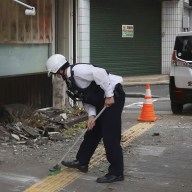VANCOUVER – A device that emits a blue light is giving patients undergoing surgery for oral cancer a fighting chance at survival and Canada is at the forefront of research that could have a global impact, researchers say.
Doctors and scientists in nine Canadian cities began testing the tool last September as part of a five-year study on 400 patients who are suffering from cancer that has afflicted their tongue or other parts of the mouth.
The hand-held fluorescence visualization tool allows surgeons to see cancer cells that can’t be detected by conventional white light so they can remove the affected tissue and prevent the disease from recurring.
Balvir Dhadda, 47, thought she’d been given a death sentence when she was diagnosed with the deadly disease four years ago after developing a sore underneath the left side of her tongue.
“When I got diagnosed, I thought `That’s it.”’
But Dhadda credits the blue light device for saving her life.
“This was the tool used on me, and the rest is history,” Dhadda said Thursday.
The tool ensured doctors removed only the tissue that was cancerous, rather than the usual practice of removing parts that might potentially be.
“I think it was a major factor in the time it took me to recover afterwards,” said Dhadda, of Surrey, B.C.
Miriam Rosin, the principle investigator of the study, said the blue-light tool developed at the BC Cancer Agency had been used to detect lung, cervical and skin cancers but is being used surgically for the first time for oral cancer.
Rosin said surgeons use the device to see cancer cells they’d otherwise miss and leaving normal tissue behind.
“When surgeons treat the disease, they catch everything that’s immediately apparent but it’s well known that a lot of the disease is scattered across the mouth,” she said.
“We showed that we could significantly stop recurrence rates,” she said of an initial study two years ago on 20 patients with early-stage oral cancer.
Rosin said the results were so promising that for the first time, teams of experts including surgeons, pathologists, research staff and scientists were brought together in nine cities across Canada to conduct the current study, which is funded by the Terry Fox Research Institute.
“It’s groundbreaking because if it works the way we hope it works, it’s going to have a big impact in the way we treat the disease and the assurance is from surgeons and from the professional societies that this will change clinical practice,” she said.
“This is a big first and the whole vision of everybody is, `Let’s get the data that will support a change in practice. It’s a major thing for Canada,” she said of the study being conducted in Vancouver, Toronto, Montreal, Ottawa , Halifax, Edmonton, Calgary, Winnipeg and London, Ont.
Every year, about 3,400 Canadians are diagnosed with oral cancer, which is deadly once it spreads to the neck, throat and lymph nodes.
“With oral cancer, about one in two people will die before five years so it’s one of the worst cancers,” said Rosin, who is also a senior scientist and director of the BC Cancer Agency’s oral cancer prevention program.
The cancer typically strikes heavy smokers and drinkers, although patients like Dhadda who don’t fit that category are being diagnosed more frequently, Rosin said.
If the study shows the blue light device to be effective, the goal is to immediately start disseminating it across Canada and eventually the world.
To help with that effort, Simon Fraser University health scientist and medical anthropologist Kitty Corbett will work with the study teams to transfer their knowledge into hospitals and doctors’ offices.
Corbett said scientists often mention in the last paragraph of published research papers that a particular study has the potential to change clinical practice, but it’s up to other professionals to make the change.
The transfer of research into real-life policies is complex and takes a long time, she said, adding that working with surgeons during the study will help her understand the challenges they face in their jobs.
“If we build this kind of partnership from the get-go we should end up getting a lot of these answers in place,” said Corbett, adding the study participants would train others in using the blue light tool.















